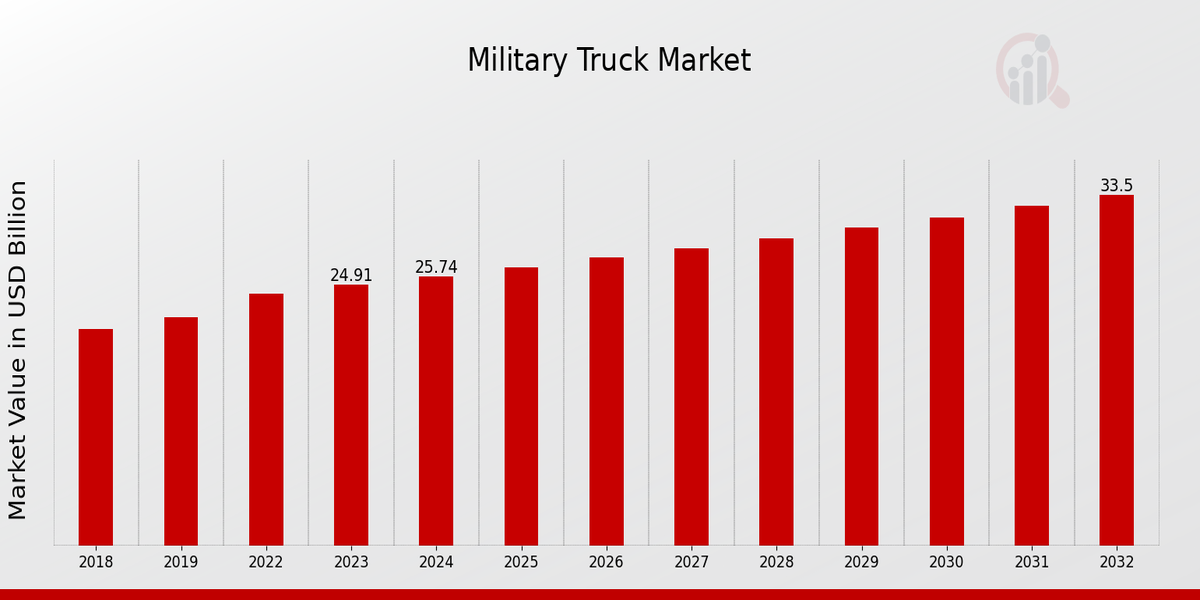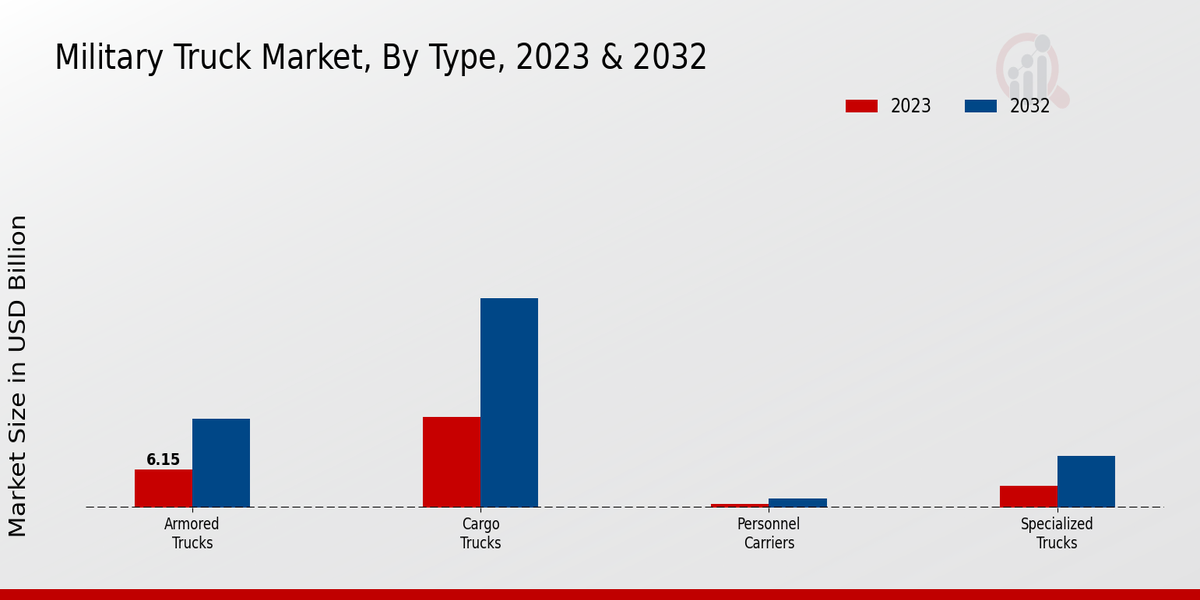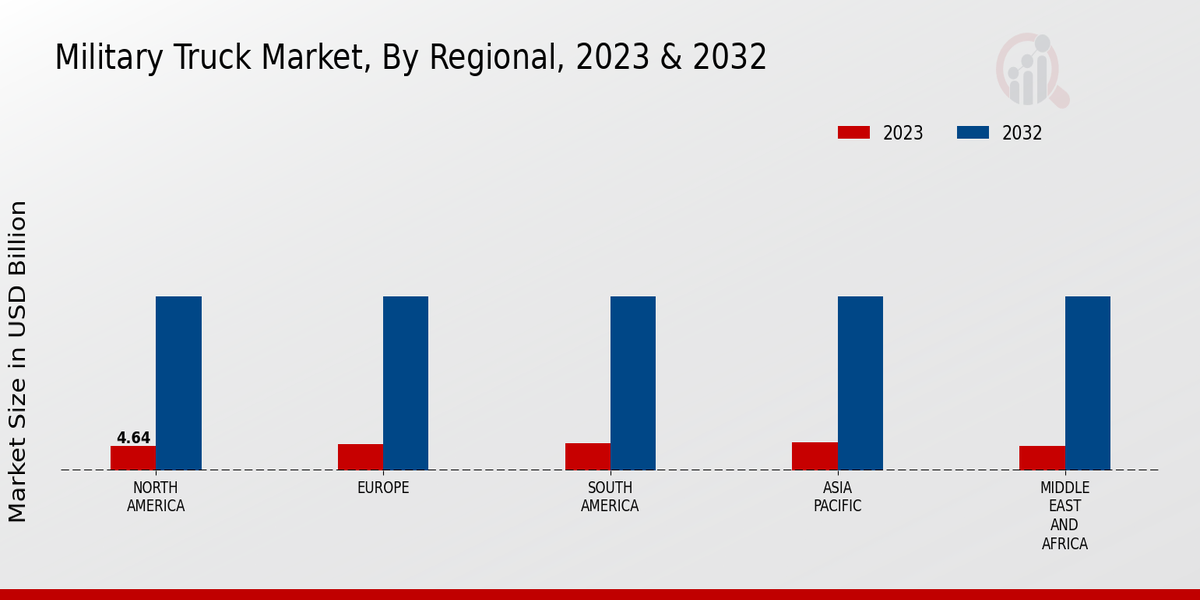Military Truck Market Overview
As per MRFR analysis, the Military Truck Market Size was estimated at 24.1 (USD Billion) in 2022. The Military Truck Market Industry is expected to grow from 24.91(USD Billion) in 2023 to 33.49 (USD Billion) by 2032. The Military Truck Market CAGR (growth rate) is expected to be around 3.35% during the forecast period (2024 - 2032).
Key Military Truck Market Trends Highlighted
The Military Truck Market is experiencing significant growth due to increased military spending, technological advancements, and geopolitical tensions. Key market drivers include the rising need for armored and protected vehicles, enhanced cargo and troop transportation capabilities, and the adoption of advanced communication and reconnaissance systems.Opportunities for market expansion lie in the development of hybrid and electric military trucks, unmanned and autonomous platforms, and customized solutions for specific mission requirements. Recent trends indicate a shift towards integrated logistics and supply chain management systems, as well as a focus on reducing operating costs and fuel consumption. Furthermore, upgrades and modernization programs are driving demand for advanced military trucks equipped with the latest technologies and capabilities.

Source Primary Research, Secondary Research, MRFR Database and Analyst Review
Military Truck Market Drivers
Advancements in Military Technology
One of the main factors driving the military truck market is the growing development of military technology. This includes, in particular, the potential development of such weapons as precision-guided munitions and unmanned aerial vehicles. Greater demand for these and other weapons systems requires better means of delivering them to their destinations in an effective and timely manner. Additionally, the increasing use of robotics and technology in military applications also requires proper military trucks to support these technologies.The Military Truck Market Industry will increase from USD 24.91 billion in 2023 to USD 33.49 billion by 2032, growing at a CAGR of 3.35% during the forecast period. The largest market is projected to be North America, and it will be followed by Europe and Asia-Pacific. The growth between 2017 and 2022 is expected in the Asia-Pacific region thanks to a rise in defense spending in countries such as China, India, and Japan.
Rising Geopolitical Tensions
Another significant driver of the military truck market is the increase in political tensions in different regions. As there are many points of conflict in various parts of the world, military trucks are heavily used for missions of all types, including for transporting troops, equipment and food to military facilities. The Military Truck Market Industry is poised to grow from USD 24.91 billion in 2023 to USD 33.49 billion by 2032, at a CAGR of 3.35% throughout the forecast period.North America will be the largest market, with Europe and Asia-Pacific following. The growth of the Asia-Pacific region is caused by the expanding defense budget of countries such as China, India, and Japan.
Increasing Defense Spending
One of the significant drivers of the military truck market is the rise in defense spending worldwide. Governments are spending considerable amounts on their military forces to make them more powerful and equip them with modern tools. Besides, the high demand for various types of passenger trucks is boosting growth in the military truck market. A few important classes of trucks are tactical, armored, and logistics trucks, and the market for each of them is expanding.It is expected to grow from USD 24.91 billion in 2023 to USD 33.49 billion in 2032 at a CAGR of 3.35% during the forecast period. The market in North America is projected to be the largest, with Europe and Asia-Pacific on its tail. The Asia-Pacific’s market is anticipated to grow due to the rise in defense spending by China, India, and Japan.
Military Truck Market Segment Insights
Military Truck Market Type Insights
The Military Truck Market is now divided by Type into three distinct categories, including Armored Trucks, Cargo Trucks, and Personnel Carriers. The Armored Trucks segment is expected to remain the largest segment of the market in 2023, capturing over 45% of the market share, as the demand for the use of armored vehicles to protect military personnel in the line of war has only been increasing with the exacerbation of wars on multiple fronts around the world.
The Cargo Trucks segment is expected to be the most quickly growing segment of the market over the forecast period, as the demand for getting supplies and equipment in and out of Goa is growing at a fast pace.Substantially less in demand and therefore expected to be substantially less profitable, the expansion of the Personnel Carriers market segment will still be at a decent volume over the forecast period, with the ability to transfer troops quickly and woolly with the least risk of deadly accidents to continue being in demand. The newly emerging category of specialized trucks includes Fuel Tankers, Recovery Vehicles, and others – the demand for the former has been rising with the use of more specialized trucks in military operations, and the category is expected to grow over the forecast period.The Military Truck Market is expected to be valued at USD 24.91 billion in 2023.

Source Primary Research, Secondary Research, MRFR Database and Analyst Review
Military Truck Market Payload Capacity Insights
There are three types of payload capacity in the military truck market that includes light, medium and heavy. The heavy payload capacity type of military truck is expected to dominate the military truck market in the near future. Growing demand for heavy massive military trucks that are designed to carry heavy and large equipment and supply is expected to increase demand for the heavy payload capacity military truck. Simultaneously, the light capacity payload segment is expected to exhibit considerable growth until the end of the forecast period.Demand for small and light weight trucks that are maneuverable, agile and designed for special operations and urban warfare is also expected to increase. The medium capacity payload segment is also expected to witness steady growth in terms of sales volume. High demand for medium-capacity trucks that are more versatile and can be effective for a wide variety of military applications.
Military Truck Market Mobility Insights
The mobility segment of the Military Truck Market is categorized into Amphibious, Off-Highway, On-Highway, and All-Terrain vehicles. Each type serves specific operational requirements. Amphibious trucks, with their ability to traverse both land and water, are crucial for military operations involving amphibious landings and coastal defense. Off-highway trucks are designed for rugged terrain, providing mobility in challenging environments like deserts, mountains, and forests.
On-highway trucks are optimized for paved roads, offering high speeds and efficiency for troop and cargo transportation.All-Terrain trucks combine the capabilities of Off-Highway and On-Highway trucks, providing versatility in diverse terrains. Factors driving the growth of this segment include increasing military spending, advancements in technology, and the need for enhanced mobility in modern warfare. Key market players in this segment include Oshkosh Defense, Rheinmetall MAN Military Vehicles, and BAE Systems.
Military Truck Market Protection Level Insights
The Military Truck Market is segmented by Protection Level into Unarmored, Light Armored, Medium Armored, and Heavy Armored. The Unarmored segment is expected to account for the largest share of the market in 2023, owing to its cost-effectiveness and wide range of applications. However, the Light Armored segment is projected to witness the highest CAGR during the forecast period, driven by the increasing demand for enhanced troop protection in combat zones. The Medium Armored segment is also expected to grow at a significant rate as military forces seek to balance protection and mobility.The Heavy Armored segment, while accounting for a smaller share of the market, is expected to remain stable over the forecast period.
Military Truck Market Regional Insights
The regional segmentation of the Military Truck Market offers insights into the market's performance across different geographic regions. North America is expected to account for a significant share of the market in 2023, owing to the region's high military expenditure and presence of leading defense contractors. Europe is another key market, driven by the demand for advanced military vehicles and the presence of established defense industries. The Asia-Pacific region is anticipated to exhibit substantial growth in the coming years, with countries like China and India investing heavily in their military capabilities.South America and the Middle East and Africa (MEA) are also expected to contribute to the market growth, albeit at a slower pace compared to other regions.

Source Primary Research, Secondary Research, MRFR Database and Analyst Review
Military Truck Market Key Players And Competitive Insights
Key players in the Military Truck Market are leaving no stone unturned in strengthening their hold in the market. They are focusing on getting their hands on the new technologies and are making aesthetic changes to increase their worth. A high level of competition is there in the Military Truck Market, which is further boosting the development of this market. Focusing on the customers’ requirements, many leading companies are providing products with the latest and modern technology, which also improves this market. In the coming years, newcomers and the current leading companies will both face a high level of competition in this market.One of the leading competitors of the Military Truck Market is Oshkosh Corporation. Several years ago, Oshkosh began delivering military vehicles to the U.S. Department of Defense and other international customers. Oshkosh Company is a top-rated company that is famous for rugged and innovative vehicle designs.
The company provides a broad range of products such as from light tactical vehicles to the heavy-duty carrier. Oshkosh Corporation provides the best products and services to their customers and their reputation in the market is very strong based on reliability and performance.Another considerable competitor of the Military Truck Market is Rheinmetall MAN Military Vehicles. This is a new company as compared to the Oshkosh Corporation and its headquarters are located in Germany. A top-rated European producer of military vehicles is the Rheinmetall MAN. To the armies throughout the world, the company offers a wide range of products. Moreover, the vehicles of Rheinmetall MAN are first-rate and produced to operate in any kind of environment. For example, the company makes heavy-duty logistic vehicles for armored personnel carriers. The reputation of Rheinmetall MAN in the market is great, and they focus on quality and new product development.
Key Companies in the Military Truck Market Include
- Tatra Trucks
- Daimler Truck AG
- Oshkosh Corporation
- BAE Systems
- ST Engineering
- Iveco Defence Vehicles
- Renault Trucks Defense
- Textron Systems
- Navistar International
- AM General
- PAC Group
- Rheinmetall
- Mine Resistant Vehicle (MRV) Technologies
- General Dynamics
- Tata Motors
Military Truck Industry Developments
BAE Systems
February, 2025: BAE Systems announced the successful testing of their latest military truck, the Armored Multi-Purpose Vehicle (AMPV), which is designed for enhanced mobility and protection in various terrains.
March, 2025: The company revealed a partnership with a tech firm to integrate advanced AI systems into their military trucks for improved logistics and operational efficiency.
ST Engineering
January, 2025: ST Engineering launched a new line of 4x4 tactical trucks equipped with modular payload capabilities, enhancing versatility for different military operations.
April, 2025: ST Engineering secured a contract with a Southeast Asian nation for the supply of their latest military logistics vehicles, aimed at boosting regional defense capabilities.
In February 2024, the U.S. Army performed tests on the sample prototype of the new Amphiscious Combat Vehicle 30mm Cannon BAE Systems.
In July 2023, an assembly plant of a recently identified M10 combat vehicle modified the second phase of low-rate initial production of Booker and accepted a US Army contract worth 257.6 million dollars to General Dynamics land systems.
Military Truck Market Segmentation Insights
Military Truck Market Type Outlook
- Armored Trucks
- Cargo Trucks
- Personnel Carriers
- Specialized Trucks (e.g., Fuel Tankers, Recovery Vehicles)
Military Truck Market Payload Capacity Outlook
- Light (less than 5 tons)
- Medium (5-15 tons)
- Heavy (more than 15 tons)
Military Truck Market Mobility Outlook
- Amphibious
- Off-Highway
- On-Highway
- All-Terrain
Military Truck Market Protection Level Outlook
- Unarmored
- Light Armored
- Medium Armored
- Heavy Armored
Military Truck Market Regional Outlook
- North America
- Europe
- South America
- Asia Pacific
- Middle East and Africa
| Report Attribute/Metric |
Details |
| Market Size 2022 |
24.1(USD Billion) |
| Market Size 2023 |
24.91(USD Billion) |
| Market Size 2032 |
33.49(USD Billion) |
| Compound Annual Growth Rate (CAGR) |
3.35% (2024 - 2032) |
| Report Coverage |
Revenue Forecast, Competitive Landscape, Growth Factors, and Trends |
| Base Year |
2023 |
| Market Forecast Period |
2024 - 2032 |
| Historical Data |
2019 - 2023 |
| Market Forecast Units |
USD Billion |
| Key Companies Profiled |
Tatra Trucks, Daimler Truck AG, Oshkosh Corporation, BAE Systems, ST Engineering, Iveco Defence Vehicles, Renault Trucks Defense, Textron Systems, Navistar International, AM General, PAC Group, Rheinmetall, Mine Resistant Vehicle (MRV) Technologies, General Dynamics, Tata Motors |
| Segments Covered |
Type, Payload Capacity, Mobility, Protection Level, Regional |
| Key Market Opportunities |
1 Enhanced troop mobility2 Improved battlefield logistics3 Advanced mission capabilities4 New vehicle protection systems5 Increased demand for specialized trucks |
| Key Market Dynamics |
Rising geopolitical tensions Increasing defense spending Advancements in military technology Growing demand for specialized vehicles Increased focus on battlefield mobility |
| Countries Covered |
North America, Europe, APAC, South America, MEA |
Frequently Asked Questions (FAQ) :
The military truck market size was valued at USD 24.91 billion in 2023 and is projected to grow to USD 33.49 billion by 2032, exhibiting a CAGR of 3.35% during the forecast period.
North America is expected to dominate the military truck market throughout the forecast period due to the presence of major defense contractors and significant military spending in the region.
The key growth drivers of the military truck market include rising geopolitical tensions, increasing defense budgets, technological advancements, and growing demand for specialized military vehicles.
The key competitors in the military truck market include Oshkosh Defense, BAE Systems, Navistar Defense, Rheinmetall MAN Military Vehicles, and Tatra Trucks.
Military trucks are primarily used for troop transportation, cargo delivery, logistics support, and specialized operations such as command and control, medical evacuation, and missile transport.
















